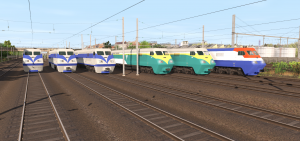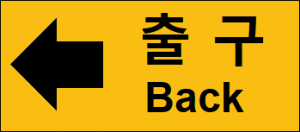Made in collaboration with British Rail MIR and Golden_Arrow

From left to right: blue and silver livery for KNR (as delivered without front coupler, with front coupler and with front coupler and without the underfloor equipment cover), yellow-green livery for both KNR and Korail, and the standard red-blue livery of Korail.
DOWNLOAD
All the necessary dependencies are either included in the package or are avaible on the DLS, except the bogeys, wich must be downloaded from JointedRail (registration required) and are included in the EMD SD40-2 BNSF H3 freeware pack. Dependencies that are not mine are property of their respective authors.
The Class 7000 Diesel-electric locomotives were introduced by the Korean National Railways in the second-half of the 1980s in order to increase the speed of Saemaeul express trains and to supplement the PP-DHC-type turbotrains, wich were being introduced at around the same time on the same services.
At that time, the vast majority of diesel locomotives in use on the KNR network was based on American designs, primarily the EMD GT26 type, an export-version of the very successful “domestic US” SD40 Type, wich had been manufactured (and was still being manufactured) in copious quantities since the mid-1960s.
KNR’s GT26-type diesel locomotives were very successful and highly favoured for their reliability and versatiliy, as they could perform very well a large variety of tasks, from top express services to local freight shunting. However, one issue remained, as like their american SD40 counterparts, the GT26s hadn’t been designed for passenger trains and as such lacked the necessary HEP equipment to keep the passenger carriages warm. This was solved by attaching a generator car to the consist, thus providing the necessary heat. However, adding a generator car meant more weight, longer trains and more maintainance costs and, since those cars didn’t carry passenger, no extra revenue to make up for all the losses.
Furthemore, with the upcoming 1986 Seoul Asian Games, and most importantly, 1988 Seoul Olympics, KNR was looking to improve it’s image, primarily by renovating it’s top express services – the Saemaeul trains. Thus, times were mature for the introduction of South Korea’s first dedicated passenger diesel-electric locomotive.
Classified as “Class 7000”, the new high-speed locomotive were to be extensively based on the existing GT26-type locomotives already in use by KNR, being effectively a streamlined (and fitted with HEP) version of the latter. However, unlike the GT26s, wich were road-switcher-type locomotives (the same cab could be used to travel in both directions), the new Class 7000s were to be straight single-ended locomotives, similarily to the F40PHs that were being built by EMD at around the same time for Amtrak.
To avoid the typical “jerk” of the GT26 type when transitioning from series to parallel during accelleration (at around 55-60Km/h) it was decided to wire the motors of the Class 7000 as a permanent parallel combination. This meant a smoother and more comfortable departure, at the expense however of a lacklustre accelleration and a diminished traction power.
As with the other GT26s, the Class 7000 was to be fitted with EMD equipment, including bogeys, the 16-645F3B prime mover and the “Dash 2” control systems. A first order for nine Class 7000 locomotives was placed to Hyundai Precision Industries (currently Hyundai-Rotem), the bearer of EMD manufacturing licenses, in 1986. All nine Class 7000s (numbered 7001 to 7009) were completed and delivered to KNR in July 1986, entering in service shortly afterwards. An additional five locomotives (7010 to 7014) were delivered a year after, in July 1987, themselves too entering service shortly after, joining the other nine locomotives already in service on Saemaeul express trains.
The Class 7000 was somewheat of a break-trough for South Korea, as it was the country’s first domestically-designed locomotive – all that came before had been designed overseas. In fact, depsite bearing an EMD model designation (FT36HCW-2*) none of the design and manufacturing had been done in the United States, not even of the prime movers or the Dash-2 electronics – all were produced in South Korea under EMD license, and considering that this was to be a locomotive for the top express trains, KNR and Hyundai were reasonably proud of it.
However, some issues soon came to light: with the HEP generator being wired directly to the prime mover, it meant that to maintain the HEP equipment operational the motor had to be always kept at high RPMs – this meant unnecessary lound noises and smoke columns (for wich a few complaints were recieved by KNR) and an inefficient fuel consumption.
Another issue found was that while running trough long tunnels, the prime movers of the Class 7000 initially developed the tendency to shut themselves off. This was due to the smoke buildup choking the engine, a fenomenon also observed on the other side of the Pacific Ocean, where in the US, a special SD40T-2 type had to be designed by EMD for services trough-long tunnels, such as on the Southern Pacific Railroad.
The single-ended design of the Class 7000 also resulted in a few operational hiccups as well, as upon arrival to the terminus, these locomotives had to travel to the nearest turntable-equipped depot (wich often was quite far away), get turned around there and return back to their train before they could depart again – something that was made a little more difficult and time-consuming due to their non-existent rear-visibility, resulting in the Class 7000 having been automatically limited to 25Km/h when running in reverse. Busan station became quickly infamous for this, as there, due to the location of the depot, the Class 7000s had to run in reverse in both moves to and fron the turntable. Soon, KNR railwaymen figured oth that it was actually quicker and simpler to just haul the Class 7000s to the turntable with a shunter and haul them back instead of having them do that on their own.
Furthemore, for the sake of maximim aereodynamic effectiveness, the Class 7000 locomotives were delivered without front couplers. This obviously impractical design fetaure was quickly fixed by retrofitting all locomotives with front couplers months after their entrance in service. Another modification made to these locomotives shortly after their introduction was the removal of the streamlined cover of the underfloor equipment, wich had little effect on aereodynamics and was overall a pain to deal with during maintainance, reason why they were all ditched within one year of service.
With some of the issues fixed, the fifteen Class 7000s became highly appreciated by drivers due to their excellent front visibility and comfortable driving position, a far cry from the “sideways” driving position of previous EMD locos (this depsite the class 7000s using the same iconic EMD-type vertical driving stand, only arranged differently!), however for the most part of their careers they remained somewheat of a pain for evryone else involved, from the maintainance equipment to the signallers and the upper KNR management, reason why further orders of Class 7000 locomotives were rescinded, in favour of a return to the “traditional” GT26s, and replaced with additional orders for the suuccessful PP-DHC Saemaeul turbotrains.
In regular service, the Class 7000 were primarily employed hauling the brand-new Saemaul stainless steel high-speed passenger coaches, wich were based on the design of the PP-DHC turbotrains, but they could be also found hauling the slightly older, squared “general type” coaches.
However, despsite the various modifications, issues with the HEP system remained persistent thruought the career of the Class 7000, reason why, exsasperated with it, in 1993 the KNR finally took the decision to remove the cumbersome apparatus (replacing it with a block of lead to act as ballast) and return to the far-less troubled generator car system, effectively making the 7000 Series on par with the rest of KNR’s diesel locomotives.
This modification finally solved most of the leftover technical issues that these locomotives where having, however operational issues still remained, with the Class 7000s becoming increasingly sidelined starting already from the 1990s, due to the introduction of even more PP-DHC sets and newer batches of GT26 type locomotives.
Starting from the mid-1990s, all of KNR’s rolling stock began to be repainted in a new standardized green, yellow and white livery, with the Class 7000s being no exception – all units lost their original silver and light blue livery by 1996. A few years later, in 2005, with the reorganization of KNR into Korail, the yellow and green livery livery was modified: the wing-shaped KNR logo being replaced by the current Korail logo and wording. Right after, the Class 7000s, togheter with the rest of the rolling stock of the newly-formed Korail began to be repainted again, this time in the latter’s new standard red, blue and white livery, wich these units would carry to their retirement.
In fact, with the introduction of the KTX high-speed services and the correlated mainline electrified services with Class 8200 electric locomotives, by the mid-2000s Class 7000 locomotives (and by extension nearly all rolling stock dedicated to Saemaeul trains, starting from the PP-DHC turbotrains) had increasingly become sidelined, being cascaded to lesser services, such as the local Mungungwha trains, for wich the Class 7000s proved unsuitable, due to their slow accelleration and suboptimal fuel consumption.
Retirements of the Class 7000 began in 2011, when the locomotives started to reach the maximium age of 25 years (as specified by South Korean law). The whole first batch of nine locomotives (7001 to 7009) was retired in one go on the 12th of December, followed by the remaining five second-batch locomotives, wich were retired by winter 2012 – the last to be taken out of service was unit 7011, wich was retired on the 28th of November.
All Class 7000 locomotives have been scrapped, except unit 7001, wich was designated as a “Railway Monument” by Korail and it’s currently preserved inside the Busan Locomotive depot.
Trivia #1:
The price of a Class 7000 locomotive in 1986 was 1.485 billion Won (nearly 5 billion won adjusted for inflation as of January 2022) equivalent to roughly 4 million current US dollars or 3.69 million Euro.
Trivia #2:
Due to their shape, the Class 7000 locomotives were quickly nicknamed “Bongo” by railwaymen, referring to the similarily-shaped first-generation Kia Bongo, a popular light truck wich was a common sight on South Korean roads.
Trivia #3:
The majority of the noise complaints for the Class 7000 came from the Daewoo Building, the then-headquarters of the Daewoo conglomerate, located right across the street from Seoul Station.
*Following EMD’s classification, “FT36HCW-2” stands for a passenger locomotive (F), with a turbo-compressor (T), an EMD645F3B prime mover (3) with 16 cylinders (6), Head-End Power (H) and Co-Co bogeys (C) with wide-type electric motors (W) and Dash-2 type control electronics (-2).
